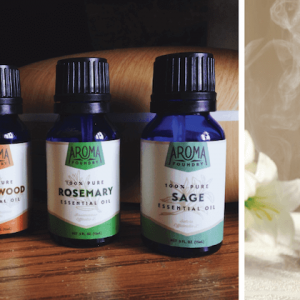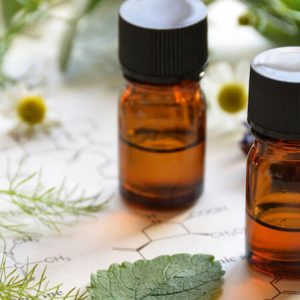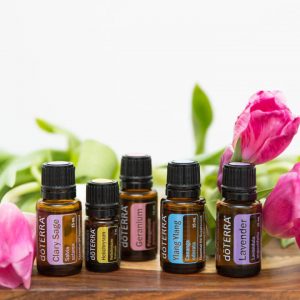Have you ever smelled something and it brought you back to a moment or memory back in time? This is because our brains are highly interconnected with different scents and smells. In fact, our sense of smell is the only sense directly tied to the limbic area of our brain. Not surprisingly enough, the limbic system deals with emotions and memory (1).
As I will soon discuss, the mechanism by which scent affects our brain can also be applied to brain injuries. There are, in fact, over 10 essential oils for brain injuries that can be used for this purpose. But first, we need to take a little look at what’s really happening when we inhale the scent molecules of an essential oil.
Aromatherapy and The Brain
Aromatherapy, or essential oil therapy, is a type of alternative medicine practice that utilizes aromatic essential oils derived from many different healing plants. While aromatherapy applies to both inhalation or topical applications, for the purpose of this article, we’ll be sticking to inhalation.
When you inhale the scent molecules of an essential oil (either straight from the bottle, diffused in the air, or breathed in via a steam bath), the olfactory system gets stimulated. The olfactory system is the part of the brain connected to smell (including the nose and the brain).
Molecules that enter the nose or mouth pass to the lungs, where they make an immediate exchange with the blood and reach other parts of the body. As these tiny molecules reach the brain, they affect our limbic system (as described earlier above), which is linked to our emotions, heart rate, blood pressure, breathing, memory, stress and hormone balance (2).
Essential oil molecules can also reach the brain through an alternative route that doesn’t involve the lungs. This allows certain molecules that cannot cross the blood-brain barrier (BBB) direct access to the central nervous system (CNS) within minutes. The molecules reach the central nervous system via the olfactory and trigeminal neural pathways – two pathways that innervate the nasal cavity, providing a direct connection with the CNS (3).
For this very reason, essential oils make excellent contenders as natural healers for brain injuries and so much more. But what components of essential oils help heal the brain? It all comes down to tiny molecules called sesquiterpenes.
Terpenes and The Blood Brain Barrier
The blood brain barrier acts like a sieve or filter through which only molecules of a certain size or smaller can pass.
When it comes to brain injuries and brain tumors, most doctors resort to invasive procedures (which, under certain circumstances are necessary). However, invasive procedures to the brain are risky, and if there were other ways to reach the brain holistically, what would someone choose? The risky route or the not-so-risky route?
Take chemotherapy for example – most of the substances and molecules used in chemotherapy are too large to pass through the blood-brain filter. This is why doctors say that chemotherapy doesn’t work on brain cancer.
According to doctors, only molecules less than 800-1000 atomic mass units (amu) in molecular weight can get through the BBB. These molecules also must be lipid soluble (meaning that water soluble molecules usually can’t make it through). Essential oils, however, meet the molecular weight requirements (less than 500 amu), and are lipid soluble, too (4).
Essential oils are mixtures of hundreds of constituents, all of which are composed of a class of organic compounds built of “isoprene units.” An isoprene unit has a molecular weight of only 68 amu (very small). Molecules that are built of isoprene units are all classified as “terpenes” – the compounds that make all essential oils unique and different.
There are three terpenes found in essential oils:
– Phenylpropanoids (also called hemiterpenes) – made up of one isoprene unit (molecular weight 68 amu)
– Monoterpenes – made up of two isoprene units (molecular weight 136 amu)
– Sesquiterpenes – made up of three isoprene units (molecular weight 204 amu)
All three of these terpenes have the ability to pass the BBB, but it is the sesquiterpenes that contain the brain oxygenating molecules. As described by Dr. David Stewart (5):
“Sesquiterpene molecules deliver oxygen molecules to cells, like hemoglobin does in the blood. Sesquiterpenes can also erase or deprogram miswritten codes in the DNA. Sesquiterpenes are thought to be especially effective in fighting cancer because the root problem with a cancer cell is that it contains misinformation, and sesquiterpenes can erase that garbled information. At the same time the oxygen carried by sesquiterpene molecules creates an environment where cancer cells can’t reproduce. Hence, sesquiterpenes deliver cancer cells a double punch-one that disables their coded misbehavior and a second that stops their growth…
The American Medical Association (AMA) has said that if they could find an agent that would pass the blood-brain barrier, they would be able to find cures for ailments such as Lou Gehrig’s disease, multiple sclerosis, Alzheimer’s disease, and Parkinson’s disease. Such agents already exist and have been available since Biblical times. The agents, of course, are essential oils-particularly those containing the brain oxygenating molecules of sesquiterpenes.”
Studies performed at Vienna and Berlin Universities found that sesquiterpenes found in essential oils of vetiver, patchouli, cedar wood, sandalwood and frankincense can increase levels of oxygen in the brain by up to 28 percent (6).
10 Essential Oils for Brain Injuries
When it comes to healing brain injuries and tumors, we should choose essential oils that contain a high percentage of sesquiterpenes to maximize oxygenation to the brain. Every injury in the body requires oxygen to promote healing. And when it comes to cancer, the cells prefer environments that are devoid of oxygen to thrive and grow. With more oxygen, cancer has a hard time staying alive.
The following essential oils are not only high in sesquiterpenes that increase oxygenation in the brain, but they contain other chemical constituents that can nourish and assist in the repair of injured brain tissue.
Sesquiterpenes are found in the following oils (7, 8):
– Cedarwood (98%)
– Vetiver (97%)
– Sandalwood (90%)
– Patchouli (71%)
– Myrrh (62%)
– Ginger (59%)
– Ylang Ylang (55%)
– Helichrysum (40%)
– Melissa (40%)
– Frankincense (8%)
It is the sesquiterpenes in these oils that are particularly effective in the remediation of hard-to-heal brain injuries.
How To Use Essential Oils for Brain Injuries
There are many different ways of using essential oils for brain injuries. One of the easiest ways is simply by inhaling the oil itself. You can do this by opening the essential oil bottle and then hovering it just below your nose so you can inhale the scent molecules.
Another way of using essential oils for brain injuries is by diffusing them into the air of your home. You can achieve this by investing in a diffuser and following the directions on the machine to see how much essential oil you can use. I typically put 10 drops in my diffuser and run it for an hour.
Lastly, you can make a steam bath by pouring hot water into a large pot and putting in 5-10 drops of essential oil. Next, place your head under a towel and over the pot, and breathe in deeply so that the oils are being inhaled.
Always purchase your essential oils from a good company. I always recommend those made by Eden’s Garden or Mountain Rose Herbs.
Precautions
Always remember that certain essential oils are toxic to cats and dogs. Never use the following essential oils around dogs or cats:
For dogs:
– Clove
– Garlic
– Juniper
– Rosemary
– Tea tree
– Thyme
– Wintergreen
For cats:
– Cassia
– Cinnamon
– Citrus
– Clove
– Eucalyptus
– Lemon
– Lavender
– Peppermint
– Spruce
– Tea tree
– Thyme









I have a friend whose son was in a car accident. He is brain dead. They took him of life support but he is unresponsive to everything and everyone. Do you have any suggestions on what type of oils to use.
Oh gosh – I’m not sure about someone who is brain dead. I’m sorry about that situation – maybe they can find a functional health practitioner who knows more in depth about those who are brain dead.